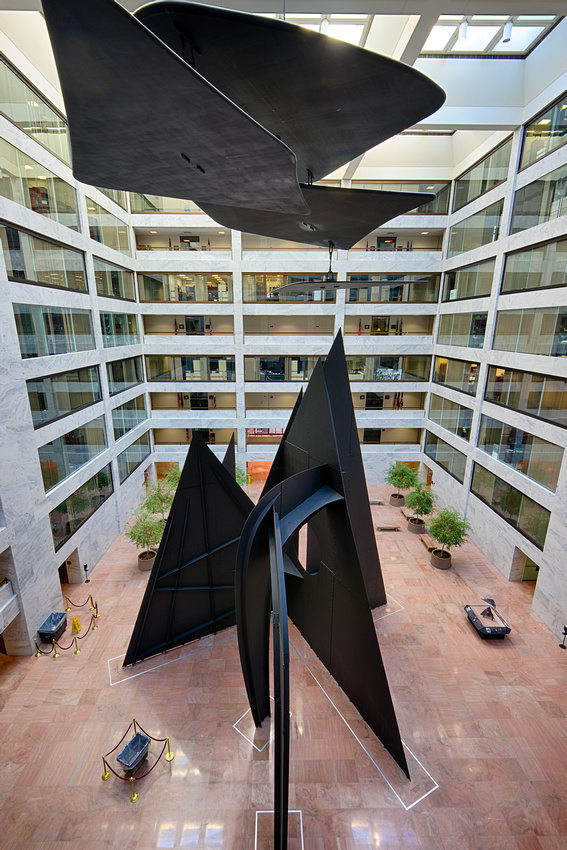
Recently, the Museum of Fine Arts Houston (MFAH) featured a show of the work of Alexander Calder and Pablo Picasso. The two were exact contemporaries and were acquainted with one another.
Like Picasso, Calder became famous for the wide range of his artistic expression. Most memorable are his ‘mobiles,’ beloved by many. These floating sculptures are the beautifully balanced hanging assemblies of wire and pieces of sheet metal. Unlike the example above, they are usually covered in bright colors or flat black paint.
His ‘stabiles‘ are floor-based sculptures that incorporate flat surfaces arranged in three-dimensional relationships, both vertical and horizontal. Some are wonderfully fluid given the curved shape of their panels, while others are geometric, more linear, and ‘edgy.’
The above photo features what I think was the final study model for La Grande Vitesse, his huge lyrical stabile which now sits on a principal downtown plaza in Grand Rapids, Michigan (which I have featured before.)
Obviously, Calder’s mobiles -especially the most successful ones- depend upon an engineer’s sensitivity for balance, while featuring his not-easily-imitable sense of proportion, shape, and color. He also blessed his mobiles with a capacity to drift quietly with the slightest breezes.
Less obvious is how the element of balance features in his stabiles. This involves the balance between vertical and horizontal elements; it also includes the balance between curved edges and flat surfaces. And finally, his stabiles incorporate the most subtle balance of all. This is the balance achieved by the artist when providing a cohesive experience of visual excitement for the viewer who sees each aspect of a stabile sculpture while walking around it.
Calder has been quoted as saying this: “The admission of approximation is necessary, for one cannot hope to be absolute in his precision. He cannot see, or even conceive of a thing from all possible points of view, simultaneously. While he perfects the front, the side, or rear may be weak; then while he strengthens the other facade he may be weakening that [one which was] originally the best. There is no end to this. To finish the work he must approximate.”
Surely, this is equally true of the spiritual life. Many of us are tempted toward the ideal of some kind of ‘perfection,’ surely never attainable by fallen humans such as ourselves. Yet, that pursuit of a kind of absoluteness and or precision, however attractive, is not true to our lives as pilgrims on an unfolding journey. Such a journey is an ancient and compelling metaphor for our lives, in Scripture and in our tradition.
So, yes, in the abstract, there are some things that are absolutely true in principle. But we so often seek and pursue them while ‘walking in circles,’ admiring the beauty, goodness and truth of what is before us. And yet, our grasp of, and appreciation for, the whole is often based on a single, or a limited number of perspectives. We then are kept from seeing the fullness of the many marvelous gifts given to us by and through our Creator’s grace-filled pursuit of us. Seeking and then finding a balance between sometimes competing perspectives and concerns can be an important step toward perceiving beauty when otherwise it may be hard to see.
I can think of no finer balanced-juxtaposition of these several elements within Calder’s extensive portfolio than the one depicted above, temporarily exhibited in the Museum of Fine Arts, Houston. A mobile gently moves above you, while you stand. You gently move around a stabile while it stands.
{my photograph; copyright reserved} / Regarding the above quote from Calder, remember that while his choice of pronouns may not be what we prefer, they were characteristic of what was considered ‘proper English’ and assumed to be fully inclusive at that time.












